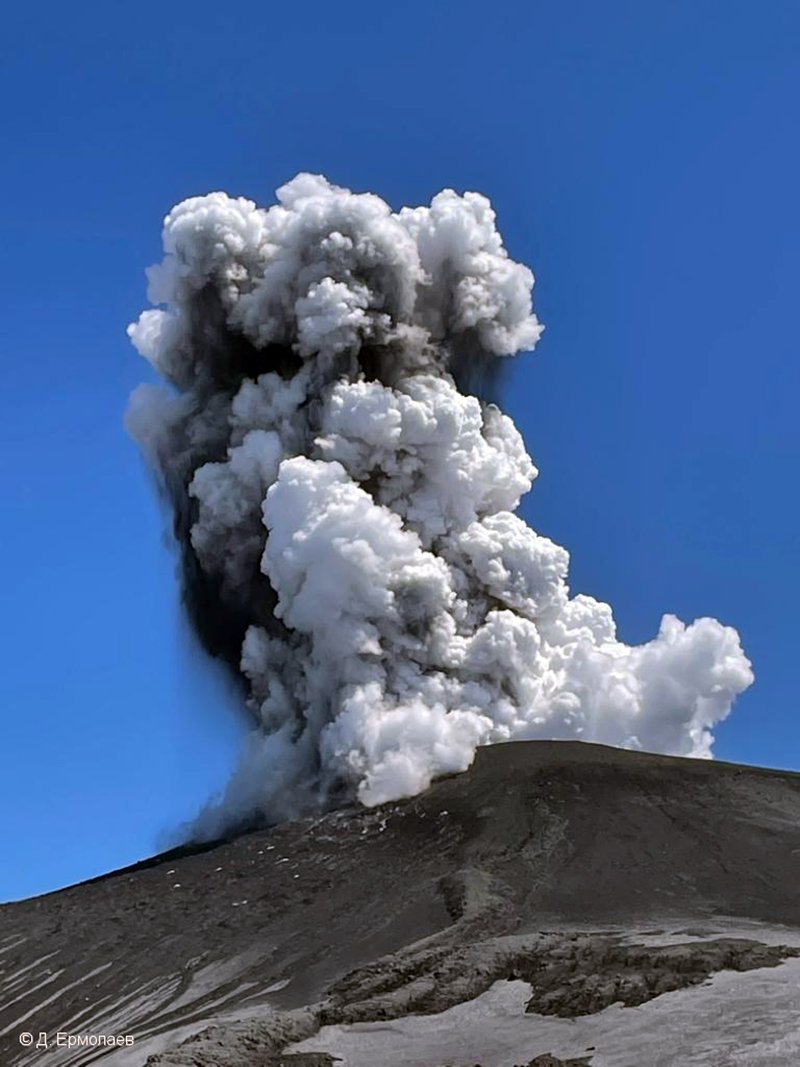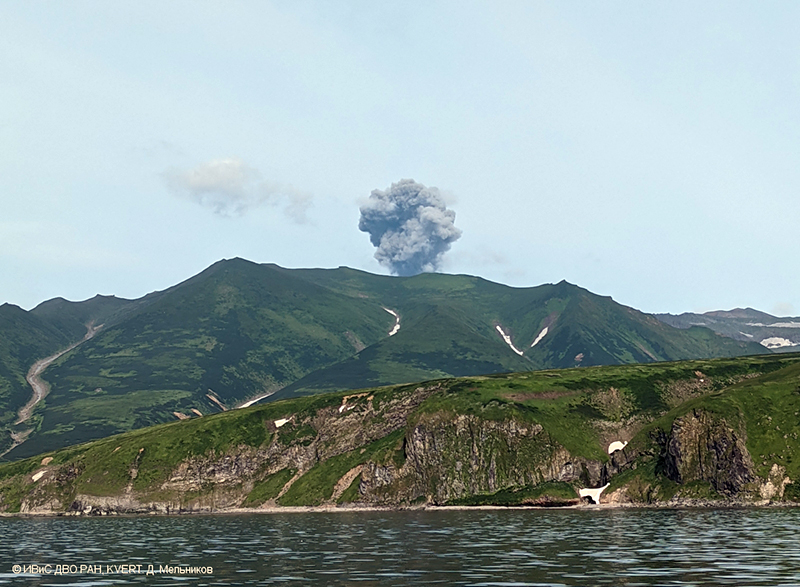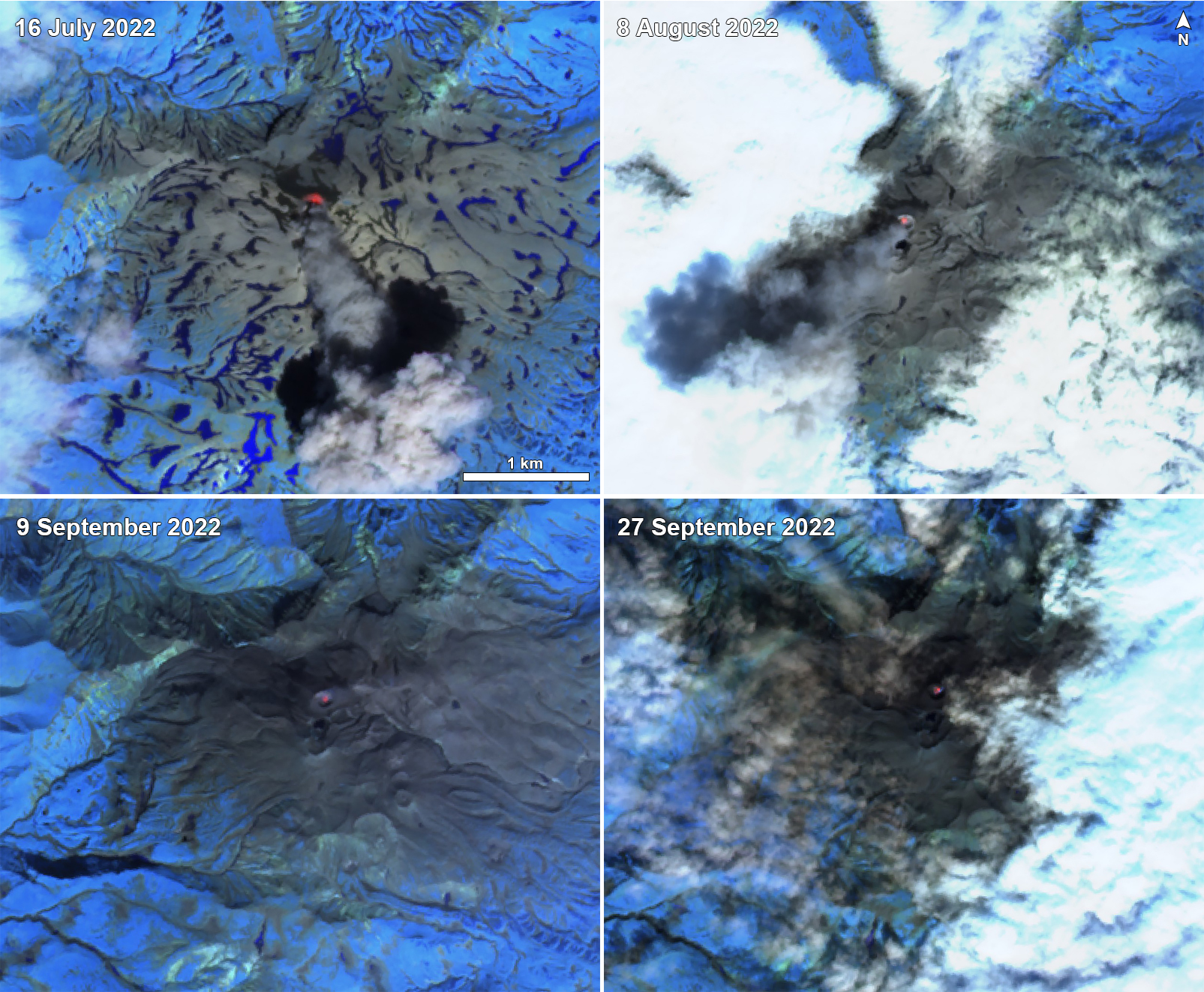Report on Ebeko (Russia) — October 2022
Bulletin of the Global Volcanism Network, vol. 47, no. 10 (October 2022)
Managing Editor: Edward Venzke.
Edited by Kadie L. Bennis.
Ebeko (Russia) Intermittent explosions, ash plumes, and thermal activity during June-September 2022
Please cite this report as:
Global Volcanism Program, 2022. Report on Ebeko (Russia) (Bennis, K.L., and Venzke, E., eds.). Bulletin of the Global Volcanism Network, 47:10. Smithsonian Institution.
Ebeko
Russia
50.686°N, 156.014°E; summit elev. 1103 m
All times are local (unless otherwise noted)
Ebeko is located on the N end of Paramushir Island in the Kuril Islands and consists of three summit craters. Eruptions dating back to the late 18th century have been characterized as small-to-moderate explosions from the summit crater, accompanied by intense fumarolic activity. The previous eruption period consisted of intermittent explosions, ash plumes, and ashfall that ended in November 2021 (BGVN 46:12). This reporting period during December 2021 through September 2022 covers a new eruption that began in June 2022 and consisted of similar intermittent explosions, ash plumes, and thermal activity, based on information from the Kamchatka Volcanic Eruptions Response Team (KVERT) and satellite data.
Activity during early December 2021 consisted of ongoing moderate gas-and-steam activity after the eruption that ended in November 2021. No significant activity was observed until 12 June 2022 when small phreatic bursts were detected, along with moderate explosions that generated ash up to 2.5 km altitude (figure 40). As a result, the Aviation Color Code (ACC) was raised to Yellow (the second lowest level on a four-color scale) on 17 June. Explosions on 18 and 22-23 June sent ash plumes to 2.5 km altitude, which drifted S, SE, and NE. A thermal anomaly was visible in satellite images on 22 June. At 1510 on 24 June an ash plume rose to 2.5 km altitude and drifted 5 km SE, which prompted KVERT to increase the ACC to Orange (the second highest level on a four-color scale). During 24-25 and 30 June explosions generated ash plumes that rose to 3.5 km altitude and drifted NW, NE, and SE.
According to volcanologists in Severo-Kurilsk (Paramushir Island, about 7 km E) explosions continued during July, generating ash plumes that rose to 2.7-3 km altitude and drifted E on 3 July; a thermal anomaly was visible in satellite images. On 7 July explosions produced ash plumes that rose to 1.8 km altitude and drifted SE as far as 5 km. During 10-11 and 13 July explosions sent ash plumes to 1.5-2.8 km altitude and drifted SE and satellite images showed a thermal anomaly over the volcano. According to observers, an explosion at 1740 local time on 16 July produced an ash plume that rose to 4.5 km altitude and drifted 5 km SE. On 27 July an explosion generated an ash plume that rose to 2.5 km altitude and drifted 10 km N (figure 41). Subsequent explosions during 28-30 July generated ash plumes to 4.5 km altitude that drifted SE and S.
Explosive activity and ash plumes continued during August. A thermal anomaly over the volcano was identified in satellite images on 1, 3-5, and 7-8 August. Webcam images from Severo-Kurilsk showed explosions that generated ash plumes to 2-3.5 that drifted as far as 3 km SE during 4-5 and 7-8 August (figure 42). A thermal anomaly was identified in satellite images on 13, 18-19, 22, and 25 August. During 15-18 August explosions generated ash plumes that rose to 3.5 km altitude. During 17-18 August ash plumes drifted more than 65 km SE and 5 km NE. Explosions during 19, 22-26, 28, and 30-31 August produced an ash plume that rose to 3.5 km altitude and drifted N, E, and NE. Thermal anomalies were visible in satellite images on 25 and 31 August. Ashfall was reported in Severo-Kurilsk on 30 August.
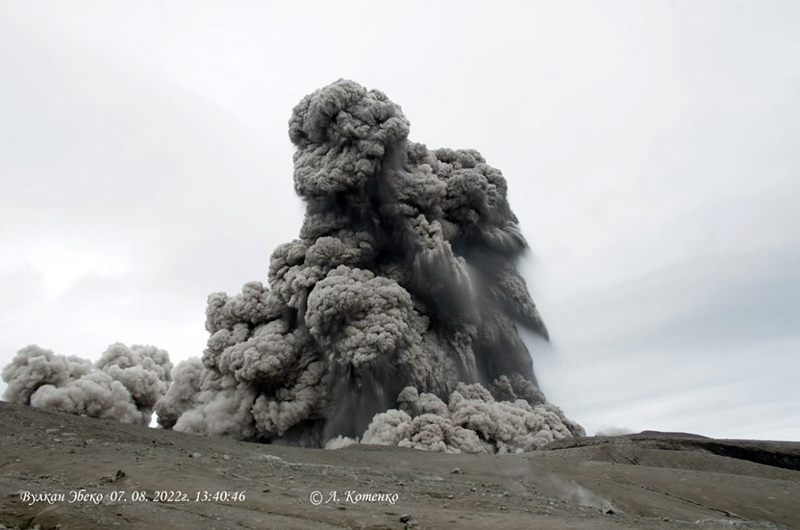 |
Figure 42. Photo of an explosive event at Ebeko on 7 August 2022 (UTC) with a strong ash plume. Image has been color corrected. Photo by L. Kotenko, courtesy of IVS FEB RAS. |
Ongoing moderate explosions continued through September, according to volcanologists in Severo-Kurilsk. Thermal anomalies were visible in satellite images during 3, 5-8, 12-13, and 18 September. During 4-5 September explosions generated ash plumes that rose to 4 km altitude and drifted as far as 50 km E and SE. On 5 and 7-8 September explosions produced ash plumes that rose to 3 km and 2-2.5 altitude and drifted 5 km SE and NNE, respectively. During 9-11 September explosions generated ash plumes that rose to 1.9-3.6 km altitude and drifted 5-7 km NNE and E. Similar explosions during 22-24 and 27-28 September produced ash plumes that rose to 3.5 km altitude and drifted E and N. As a result, ashfall was reported in Severo-Kurilsk during 9-10 and 20-23 September. On 23 and 28 September webcam images showed an explosion that produced an ash plume to 2.7 km and 1.9 altitude and drifted 5 km E, respectively. Ashfall was also reported in Severo-Kurilsk during 28 September. A thermal anomaly was visible on 23 and 28 September in satellite data.
According to MIROVA (Middle InfraRed Observation of Volcanic Activity) data, four low-power thermal anomalies were detected during late July and early to mid-August 2022 (figure 43). This thermal activity, also seen in Sentinel-2 infrared satellite images, was sometimes accompanied by ash plumes that drifted SE and SW from the summit due to frequent explosions (figure 44).
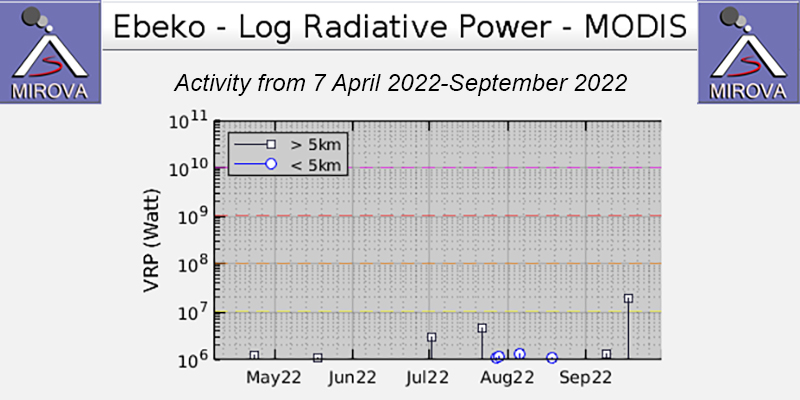 |
Figure 43. Four low-power thermal anomalies were detected at Ebeko during late July and early to mid-August 2022 as recorded by the MIROVA graph (Log Radiative Power). Courtesy of MIROVA. |
Geological Summary. The flat-topped summit of the central cone of Ebeko volcano, one of the most active in the Kuril Islands, occupies the northern end of Paramushir Island. Three summit craters located along a SSW-NNE line form Ebeko volcano proper, at the northern end of a complex of five volcanic cones. Blocky lava flows extend west from Ebeko and SE from the neighboring Nezametnyi cone. The eastern part of the southern crater contains strong solfataras and a large boiling spring. The central crater is filled by a lake about 20 m deep whose shores are lined with steaming solfataras; the northern crater lies across a narrow, low barrier from the central crater and contains a small, cold crescentic lake. Historical activity, recorded since the late-18th century, has been restricted to small-to-moderate explosive eruptions from the summit craters. Intense fumarolic activity occurs in the summit craters, on the outer flanks of the cone, and in lateral explosion craters.
Information Contacts: Kamchatka Volcanic Eruptions Response Team (KVERT), Far Eastern Branch, Russian Academy of Sciences, 9 Piip Blvd., Petropavlovsk-Kamchatsky, 683006, Russia (URL: http://www.kscnet.ru/ivs/kvert/); MIROVA (Middle InfraRed Observation of Volcanic Activity), a collaborative project between the Universities of Turin and Florence (Italy) supported by the Centre for Volcanic Risk of the Italian Civil Protection Department (URL: http://www.mirovaweb.it/); Sentinel Hub Playground (URL: https://www.sentinel-hub.com/explore/sentinel-playground).


